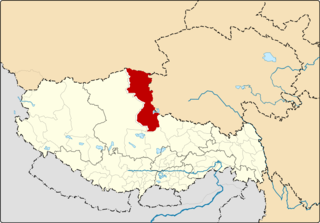Related Research Articles
Khams Tibetan is the Tibetic language used by the majority of the people in Kham. Khams is one of the three branches of the traditional classification of Tibetic languages. In terms of mutual intelligibility, Khams could communicate at a basic level with the Ü-Tsang branch.
Qiangic is a group of related languages within the Sino-Tibetan language family. They are spoken mainly in Southwest China, including Sichuan, Tibet and Yunnan. Most Qiangic languages are distributed in the prefectures of Ngawa, Garzê, Ya'an and Liangshan in Sichuan with some in Northern Yunnan as well.
The Pumi language is a Qiangic language used by the Pumi people, an ethnic group from Yunnan, China, as well as by the Tibetan people of Muli in Sichuan, China. Most native speakers live in Lanping, Ninglang, Lijiang, Weixi and Muli.

Chamdo, officially Qamdo and also known in Chinese as Changdu, is a prefecture-level city in the eastern part of the Tibet Autonomous Region, China. Its seat is the town of Chengguan in Karuo District. Chamdo is Tibet's third largest city after Lhasa and Shigatse.

Ngari Prefecture or Ali Prefecture is a prefecture of China's Tibet Autonomous Region covering Western Tibet, whose traditional name is Ngari Khorsum. Its administrative centre and largest settlement is the town of Shiquanhe. It is one of the least densely populated areas in the world, with 0.3 people per kilometer.
The SASM/GNC/SRC romanization of Tibetan, commonly known as Tibetan pinyin or ZWPY, is the official transcription system for the Lhasa dialect of the Tibetan language for personal names and place names in China. It is based on the pronunciation used by China National Radio's Tibetan Radio, which is based on the pronunciation of the Lhasa dialect, and reflects its pronunciation, except that it does not mark tone. It has been used within China as an alternative to the Wylie transliteration for writing Tibetan in the Latin script since 1982.

Lhasa Tibetan, or Standard Tibetan, is the Tibetan dialect spoken by educated people of Lhasa, the capital of the Tibetan Autonomous Region of China. It is an official language of the Tibet Autonomous Region.

Shuanghu County, also transliterated from Tibetan as Co Nyi County, is a county under the jurisdiction of the prefecture-level city of Nagqu, in the northernmost part of the Tibet Autonomous Region, People's Republic of China. It was formed in 2012, combining the territory of the former Shuanghu Special District with the eastern half of Nyima County. Much of the county is within the Changtang area.
Naxi, also known as Nakhi, Nasi, Lomi, Moso, Mo-su, is a Sino-Tibetan language or group of languages spoken by some 310,000 people, most of whom live in or around Lijiang City Yulong Naxi Autonomous County of the province of Yunnan, China. Nakhi is also the ethnic group that speaks it, although in detail, officially defined ethnicity and linguistic reality do not coincide neatly: there are speakers of Naxi who are not registered as "Naxi" and citizens who are officially "Naxi" but do not speak it.

The Gyalrongic languages constitute a branch of the Qiangic languages of Sino-Tibetan, although some propose that it may be part of a larger Rung languages group, and do not consider it to be particularly closely related to Qiangic, suggesting that similarities between Gyalrongic and Qiangic may be due to areal influence. However, other work suggests that Qiangic as a whole may in fact be paraphyletic, with the only commonalities of the supposed "branch" being shared archaisms and areal features that were encouraged by contact. Jacques & Michaud (2011) propose that Qiangic including Gyalrongic may belong to a larger Burmo-Qiangic group based on some lexical innovations.
The Jingpho-Luish, Jingpho-Asakian, Kachin–Luic, or Kachinic languages are a group of Sino-Tibetan languages belonging the Sal branch. They are spoken in eastern India and Burma, and consist of the Jingpho language and the Luish languages Sak, Kadu, Ganan, Andro, Sengmai, and Chairel. Ethnologue and Glottolog include the extinct or nearly extinct Taman language in the Jingpo branch, but Huziwara (2016) considers it to be unclassified within Tibeto-Burman.
The West Himalayish languages, also known as Almora and Kanauric, are a family of Sino-Tibetan languages centered in Himachal Pradesh, Uttarakhand and across the border into Nepal. LaPolla (2003) proposes that the West Himalayish languages may be part of a larger "Rung" group.

The Lolo-Burmese languages of Burma and Southern China form a coherent branch of the Sino-Tibetan family.
Sak is a Sino-Tibetan language of the Sal branch spoken in Bangladesh and Myanmar.
The Naish languages are a low-level subgroup of Sino-Tibetan languages that include Naxi, Na (Mosuo), and Laze.
Basum is a divergent Bodish language spoken by about 2,500 people in Gongbo'gyamda County 工布江达县, Nyingtri Prefecture, Tibet, China. Basum is spoken by 13.5% of the population of Gongbo'gyamda County. Glottolog lists Basum as unclassified within Bodish.
Chamdo Region or Qamdo Region was a province-level area of the People's Republic of China comprising most of the western Kham region of traditional Tibet, where the Khampa, a subgroup of the Tibetan people, live. Chamdo split from Xikang Province in 1950 after the Battle of Chamdo. Chamdo was merged into Tibet Autonomous Region in 1965.
Lamo is an unclassified Sino-Tibetan language spoken in Tshawarong, Zogang County, Chamdo Prefecture, Tibet. It was recently documented by Suzuki & Nyima (2016). sMad skad, a closely related language variety, is also spoken in Tshawarong.
Larong or Zlarong is a recently documented Sino-Tibetan language spoken in Zogang and Markam counties of southeastern Chamdo, Tibet. It was recently documented by Zhao (2018) and Suzuki & Nyima (2018). Zhao (2018) tentatively classifies Zlarong as a Qiangic language.
Drag-yab is a Sino-Tibetan language recently documented by Suzuki & Nyima. It is spoken in the southern half of Zhag'yab County, Chamdo, eastern Tibet.
References
- 1 2 Suzuki, Hiroyuki and Tashi Nyima. 2018. Historical relationship among three non-Tibetic languages in Chamdo, TAR. Proceedings of the 51st International Conference on Sino-Tibetan Languages and Linguistics (2018). Kyoto: Kyoto University.
- ↑ Zhao, Haoliang. 2018. A brief introduction to Zlarong, a newly recognized language in Mdzo sgang, TAR. Proceedings of the 51st International Conference on Sino-Tibetan Languages and Linguistics (2018). Kyoto: Kyoto University.
- ↑ Jacques, Guillaumes. 2016. Les journées d'études sur les langues du Sichuan.
- 1 2 Tashi Nyima; Hiroyuki Suzuki (2019). "Newly recognised languages in Chamdo: Geography, culture, history, and language". Linguistics of the Tibeto-Burman Area. 42 (1): 38–81. doi: 10.1075/ltba.18004.nyi . ISSN 0731-3500.
- ↑ Jiang, Huo 江荻 (2022). "Linguistic diversity and classification in Tibet 西藏的语言多样性及其分类". Zhongguo Zangxue 中国藏学. 6. Retrieved 2023-03-16– via Chinese Tibetology Center 中国藏学研究中心.
- ↑ Xizang Changdu Diqu Difangzhi Bianzuan Weiyuanhui 西藏昌都地区地方志编纂委员会 (2005). Changdu Diquzhi 昌都地区志. Beijing: Fangzhi Chubanshe 方志出版社.
